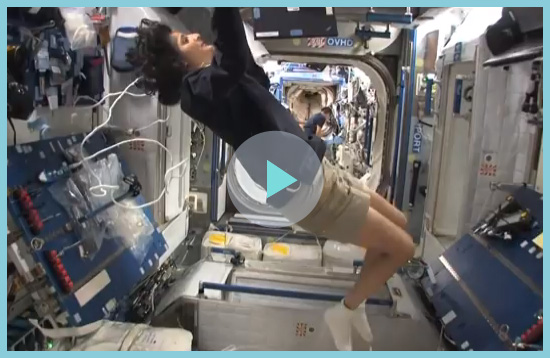-
Mo
d u
larLiv
ingAt home on the ISS
by Sophie Lovell
Expedition 16 Commander Peggy Whitson participates in a session of extravehicular activity (EVA) as construction continues on the ISS, 2007. (Photo: NASA)
-
Some 400 kilometres above our heads, hurtling along at 27,600 kilometres per hour, is possibly the most extraordinary – and certainly the most expensive – building ever created, located in the most hostile environment known. The International Space Station (ISS) has been in continuous occupation for the past 13 years. It provides a cramped yet highly-ordered home, workplace and life-support for between three and ten people at any one time, and is run collaboratively by sixteen nations and five different space agencies from Russia, the US, Japan, Canada and Europe: Roscosmos, NASA, JAXA, CSA and ESA respectively.
Since its inception with the first Russian module Zarya in 1998, the ISS has continually grown and now provides 837 cubic metres of living space for its crew, within sixteen modules. Inhabitants live there in weightless conditions for up to six months at a time, so considerable attention is paid to their health and well-being with a range of exercise facilities including a treadmill, bench press and exercise bike. There is even a “cupola” module functioning as a form of balcony or picture window for residents to enjoy views of earth below and space beyond in their spare time. Two further Russian research modules, the Nauka and the Uzlovy are due to dock onto the ISS in 2014, and in 2015 the private company Bigelow Aerospace will send up its BEAM module for testing – an inflatable structure which could prove ground-breaking as a lightweight prototype for space habitation.
Because the ISS orbits the earth once every 92 minutes, the “days” are very short, so the 10-hour workday is regulated according to a Mission Elapsed time schedule. The astronauts’ diets are devised according to preferences and needs, with food preserved in refrigerated, frozen and canned form. Water is recycled and the station is self-sufficient in this respect. Energy is primarily supplied through solar power collected by a complex 12,000 square-metre solar-array system of sails attached to the structure. -
In this recording, an astronaut on one of the first missions by space shuttle Discovery announces: “It’s nice to be in orbit”. The photo was taken by an STS-133 Discovery crew member after the station and shuttle began separation and Discovery made its final return to Earth in 2011. (Sound and photo: NASA)
-
Russian cosmonaut Anton Shkaplerov, Expedition 30 flight engineer, participates in an EVA session to continue outfitting the ISS in 2012. (Photo: NASA)
-
This recording is not from the ISS but from the 1962 Mercury 6 mission, which carried John Glenn and made him the first astronaut to orbit the earth. In this photo, astronaut Mike Fossum transfers payload during a spacewalk in 2011 for the Robotics Refuelling Mission. (Sound and photo: NASA)
-
NASA astronaut Ron Garan, Expedition 28 flight engineer, looking out of a window of the ISS Cupola, 2011. (Photo: NASA)
-
Interior view of the Destiny laboratory on the ISS during the Expedition 7 mission, 2003. (Photo: NASA)
-
Scheduled to remain in service until 2024, the original function of the ISS was to serve as a scientific research base, but today it provides an educational role as well, with regular interactive broadcasts between resident astronauts and students on earth. With increasing private and state interests in the future potential of mining passing asteroids, the Moon, and even Mars for valuable minerals, the ISS now looks to be taking on a growing commercial role: as a staging post for a nascent twenty-first century gold rush... I

Expedition 33 Commander Suni Williams gives a tour of sleeping and bathroom facilities on the ISS. (Video courtesy NASA)
-
Search
-
FIND PRODUCTS
PRODUCT GROUP
- Building Materials
- Building Panels
- Building technology
- Façade
- Fittings
- Heating, Cooling, Ventilation
- Interior
- Roof
- Sanitary facilities
MANUFACTURER
- 3A Composites
- Alape
- Armstrong
- Caparol
- Eternit
- FSB
- Gira
- Hagemeister
- JUNG
- Kaldewei
- Lamberts
- Leicht
- Solarlux
- Steininger Designers
- Stiebel Eltron
- Velux
- Warema
- Wilkhahn
-
Follow Us
Tumblr
New and existing Tumblr users can connect with uncube and share our visual diary.
»Form follows feminine.«
Oscar Niemeyer
Keyboard Shortcuts
- Supermenu
- Skip Articles
- Turn Pages
- Contents




